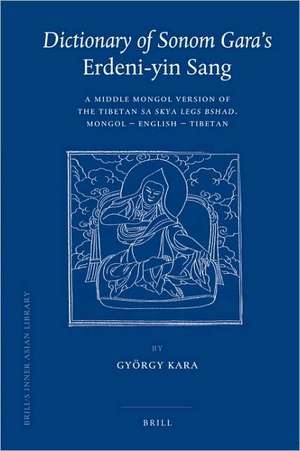Dictionary of Sonom Gara's <i>Erdeni-yin Sang</i>: A Middle Mongol Version of the Tibetan <i>Sa skya Legs bshad</i>. Mongol - English - Tibetan: Brill's Inner Asian Library, cartea 23
Autor Györgi Karaen Limba Engleză Hardback – 30 iul 2009
Din seria Brill's Inner Asian Library
- 15%
 Preț: 465.98 lei
Preț: 465.98 lei - 18%
 Preț: 844.24 lei
Preț: 844.24 lei - 18%
 Preț: 894.22 lei
Preț: 894.22 lei - 18%
 Preț: 586.66 lei
Preț: 586.66 lei - 33%
 Preț: 888.38 lei
Preț: 888.38 lei - 18%
 Preț: 1035.45 lei
Preț: 1035.45 lei - 18%
 Preț: 723.46 lei
Preț: 723.46 lei - 18%
 Preț: 527.56 lei
Preț: 527.56 lei - 18%
 Preț: 588.82 lei
Preț: 588.82 lei - 18%
 Preț: 1285.56 lei
Preț: 1285.56 lei - 18%
 Preț: 747.04 lei
Preț: 747.04 lei - 18%
 Preț: 1056.58 lei
Preț: 1056.58 lei - 18%
 Preț: 1445.59 lei
Preț: 1445.59 lei - 18%
 Preț: 525.18 lei
Preț: 525.18 lei - 18%
 Preț: 681.99 lei
Preț: 681.99 lei - 18%
 Preț: 727.80 lei
Preț: 727.80 lei - 18%
 Preț: 620.55 lei
Preț: 620.55 lei - 18%
 Preț: 778.46 lei
Preț: 778.46 lei - 18%
 Preț: 765.59 lei
Preț: 765.59 lei - 18%
 Preț: 712.65 lei
Preț: 712.65 lei - 18%
 Preț: 694.05 lei
Preț: 694.05 lei - 18%
 Preț: 938.61 lei
Preț: 938.61 lei - 18%
 Preț: 1017.72 lei
Preț: 1017.72 lei - 5%
 Preț: 1086.96 lei
Preț: 1086.96 lei - 18%
 Preț: 820.37 lei
Preț: 820.37 lei - 18%
 Preț: 638.09 lei
Preț: 638.09 lei - 18%
 Preț: 685.04 lei
Preț: 685.04 lei - 18%
 Preț: 634.61 lei
Preț: 634.61 lei - 18%
 Preț: 546.78 lei
Preț: 546.78 lei - 18%
 Preț: 819.18 lei
Preț: 819.18 lei - 18%
 Preț: 739.32 lei
Preț: 739.32 lei - 18%
 Preț: 967.34 lei
Preț: 967.34 lei - 18%
 Preț: 592.44 lei
Preț: 592.44 lei - 15%
 Preț: 530.25 lei
Preț: 530.25 lei - 15%
 Preț: 472.47 lei
Preț: 472.47 lei - 18%
 Preț: 583.44 lei
Preț: 583.44 lei - 18%
 Preț: 634.25 lei
Preț: 634.25 lei - 18%
 Preț: 893.84 lei
Preț: 893.84 lei - 18%
 Preț: 1537.83 lei
Preț: 1537.83 lei - 18%
 Preț: 1606.79 lei
Preț: 1606.79 lei - 18%
 Preț: 631.13 lei
Preț: 631.13 lei - 18%
 Preț: 750.97 lei
Preț: 750.97 lei - 18%
 Preț: 840.36 lei
Preț: 840.36 lei
Preț: 887.62 lei
Preț vechi: 1082.46 lei
-18% Nou
Puncte Express: 1331
Preț estimativ în valută:
169.87€ • 173.96$ • 141.30£
169.87€ • 173.96$ • 141.30£
Carte indisponibilă temporar
Doresc să fiu notificat când acest titlu va fi disponibil:
Se trimite...
Preluare comenzi: 021 569.72.76
Specificații
ISBN-13: 9789004175792
ISBN-10: 9004175792
Pagini: 338
Dimensiuni: 160 x 240 mm
Greutate: 0.77 kg
Editura: Brill
Colecția Brill
Seria Brill's Inner Asian Library
ISBN-10: 9004175792
Pagini: 338
Dimensiuni: 160 x 240 mm
Greutate: 0.77 kg
Editura: Brill
Colecția Brill
Seria Brill's Inner Asian Library
Notă biografică
György Kara, longtime Professor of Inner Asian studies at University of Budapest, currently Professor at Indiana University, Bloomington, published on Mongol, Turkic and Tibetan philology, including Chants d’un barde mongol (Budapest, 1972) and Books of the Mongolian Nomads (Bloomington, 2005).
Recenzii
"Kara’s edition also includes the entire vocabulary of several other texts of the fourteenth century, and it offers parallel readings from the seventeenth- and eighteenth-century Mongolian translations.Giving a historical perspective on Mongolian techniques of translation, it facilitates a more accurate reading of secular and Buddhist literary works abounding in Middle Mongolian lexicon and forms. Kara’s learned introduction discusses the strophic structure, orthography, phonetics, lexicon, and grammar of Sonom Gara’s language, and shows inconsistencies between the Tibetan and Middle Mongolian versions. This dictionary will greatly benefit both Mongolian language scholars and scholars of Buddhism seeking to make sense of Mongolian translations of Tibetan Buddhist texts."
VESNA A. WALLACE, University of California, Santa Barbara, Religious Studies Reviews Volume 37 (2011)
VESNA A. WALLACE, University of California, Santa Barbara, Religious Studies Reviews Volume 37 (2011)
